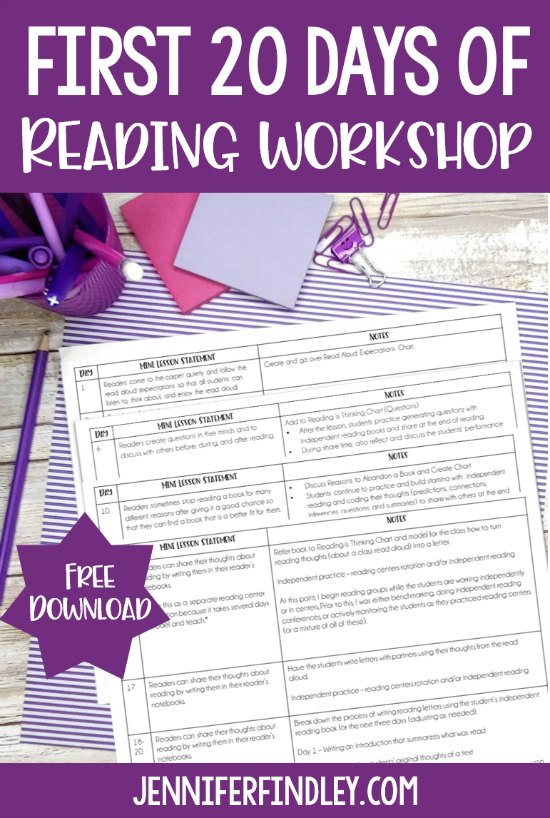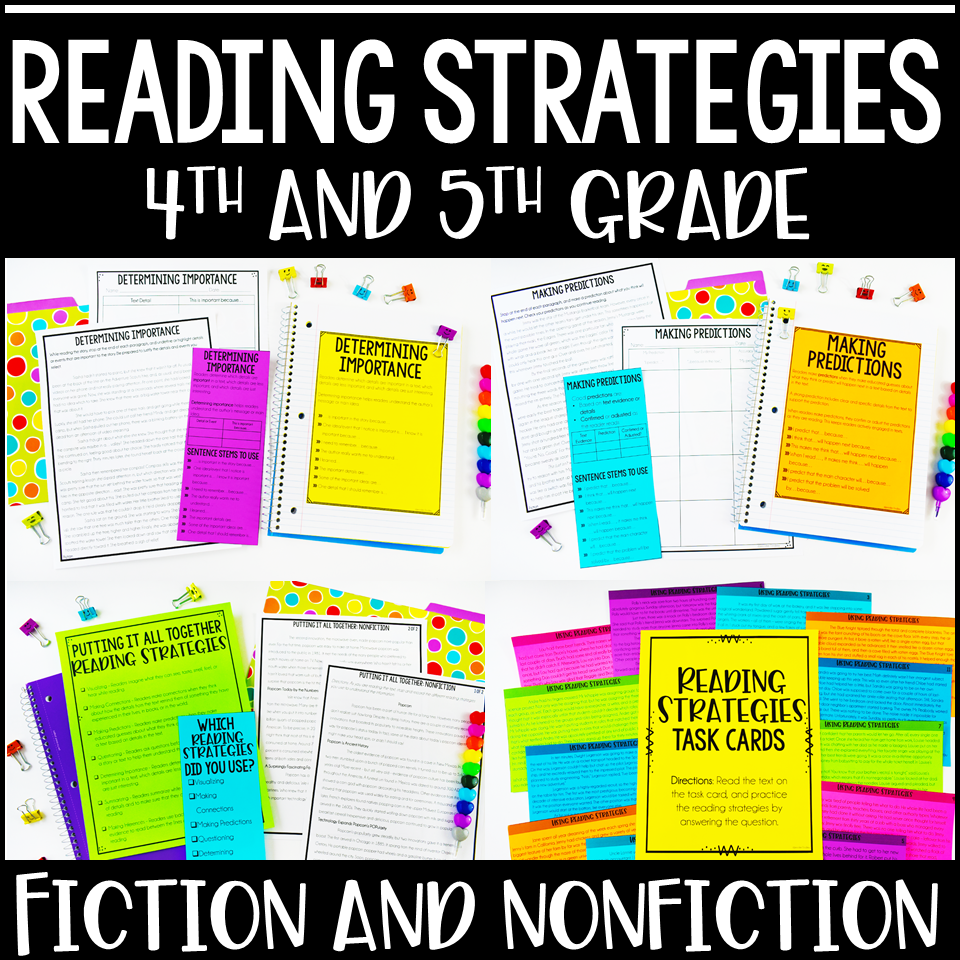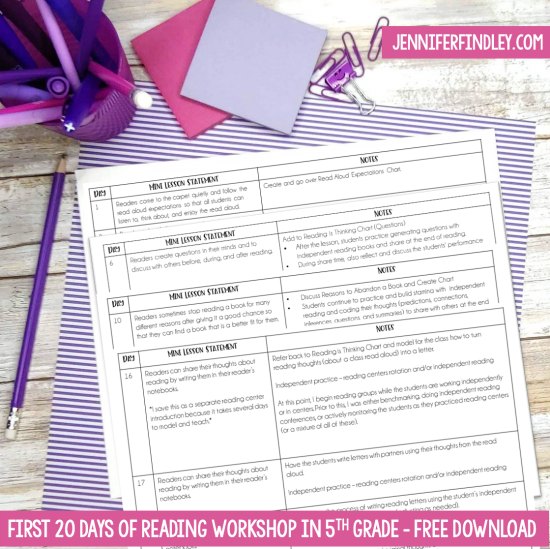The first 20 days of reading instruction is such a valuable time. This is your chance to teach expectations and procedures and get your students engaged and excited about reading. This post will share a look into my first 20 days of reading workshop, including a free PDF version with my notes.

Purpose of the First 20 Days of Reading Instruction
The first 20 days are so important to ensuring the success of your reading workshop for the rest of the year.
This is the time to:
- Model expectations and procedures
- Reteach or teach necessary skills that are not in your reading curriculum but still very important
- Get to know your students as readers
- Set up a culture of readers
- Fill in gaps in reading behaviors
- Help your students build stamina and strong reading habits
- Get lots of anecdotal notes for future small group lessons
Choosing Your Mini-Lessons
I will share my first 20 days mini-lessons with comments, but I also want to share some notes on how I chose these lessons. I occasionally do modify the lessons from year to year to fit the specific needs of my readers using the questions below to guide me.
When choosing your mini-lessons, ask yourself:
- What reading behaviors have my past students consistently done that hinders their engagement or comprehension?
- What reading behaviors have my past students not exhibited that would have helped them grow as readers?
- What embedded reading skills or behaviors do my students lack from year to year?
- What expectations and procedures are important to ensure our reading time goes well all year?
- What behaviors or skills do I want to model that will benefit my students during reading centers, independent reading, literature circles, partner reading, etc.?
- How is the reading stamina of my students? Have they been expected to read or work on reading tasks independently for long periods of time in previous grades?
The answers to your questions will guide what mini-lessons you choose to teach, not teach, or adjust and modify.
My First 20 Days of Reading Workshop in 5th Grade
Here are my first 20 days of reading instruction. Click here to grab a PDF version with notes and links to helpful resources.
Day 1 – Readers come to the carpet quietly and follow the read aloud expectations so that all students can listen to, think about, and enjoy the read aloud.
Day 2 – Readers talk with their partners about the read aloud so they can share their thoughts about the text.
Day 3 – Readers choose books that are just right for them so they can understand, enjoy, and learn from what they are reading.
Day 4 – Two Lessons – 1st Lesson: Readers keep a record of their reading so they can notice patterns and set goals as readers. Introduce reading log expectations.
2nd Lesson: Readers follow reading expectations so that they can become better readers and their classmates can as well.
Day 5 – Readers use a variety of reading strategies so that they can think about the text while reading.
Day 6 – Readers create questions in their minds and to discuss with others before, during, and after reading.
Day 7 – Readers summarize the key details and events from their reading so they can share their ideas with others.
Day 8 – Readers read between the lines and make inferences while they are reading so they can fully understand the author’s message or topic of the text.
Day 9 – Good readers make sure that the words they are reading look right, sound right, and make sense while they are reading. Readers have many strategies for solving challenging words so that they can continue to understand the author’s message. *This lesson is continued throughout guided reading groups for students who need it so this serves as an introductory lesson or review for the entire class.
Day 10 – Readers sometimes stop reading a book for many different reasons after giving it a good chance so that they can find a book that is a better fit for them.
Day 11- Readers can practice reading skills in a variety of ways, including through reading centers.
Days 12-13 – Readers can work together with partners or small groups on reading activities and tasks.*The number of days will depend on how many reading centers you are introducing.*
Days 14-15 – Readers can transition from reading activities in a way that does not distract others. *This is two days because it takes two days for the students to rotate through the reading centers. For the second day, I will either continue the reading lesson focus or choose a new focus depending on observations from their reading behaviors from Day 14.*
Day 16 – Readers can share their thoughts about reading by writing them in their reader’s notebooks.*I save this as a separate reading center introduction because it takes several days to model and teach.*
Day 17- Readers can share their thoughts about reading by writing them in their reader’s notebooks.
Days 18-20 – Readers can share their thoughts about reading by writing them in their reader’s notebooks.
***Download a PDF version with notes for each day by clicking here.
What Happens After the Mini-Lesson Each Day
After each mini-lesson, the students are practicing independent reading, reading with partners, or participating in reading centers. The first few days are independent reading because we are building stamina and then we move to reading centers on Day 11.
Depending on the mini-lesson, they are also applying or practicing what they have learned to their independent reading or reading center work. For example, on Day 6 the students learn about the importance of asking questions before, during, and after reading. While they are independently reading, they will be practicing this reading skill.
After the independent (or partner/reading center) practice, we come back together as a class to share our reading thoughts and reflect on our reading behaviors.
Here is the basic breakdown of my reading block during this time:
- Mini-Lesson
- Independent reading or reading centers
- Closing/Share
While the students are reading independently or working on reading centers, I am observing their behaviors, taking anecdotal notes, benchmarking students, and conducing independent reading conferences. Click here to read a post to help you get started with independent reading conferences.
Next Steps After the First 20 Days of Reading Instruction
After the first 20 days of reading instruction, our whole group lessons move right into grade level skills. Click here to see my 5th grade literacy pacing guide to see how I pace my reading standards.
Click here for more information about how I teach grade level reading skills.
Any behaviors or concerns that I observed or took note of during the first 20 days will be addressed through small group reading instruction, unless the majority of the class has that behavior or concern. If the majority of the class still has behaviors or concerns that need addressed, I will add to my 20 days (or adjust and modify).
If I notice that a lot of my students struggle with reading comprehension and applying reading strategies to more difficult text, I use this resource for my first month of small group reading instruction. It allows me to explicitly teach reading strategies, as well as allow my students to practice the skills with rigorous texts (fiction and nonfiction).
Shop This Post

Reading Strategies
Do your students struggle to comprehend grade level texts? This resource provides everything you need for direct instruction of seven key reading strategies that improve reading comprehension. The reading strategies include visualizing, making connections, making predictions, questioning, determining importance, summarizing, and inferring. Fiction texts and nonfiction texts are included to allow your students to work on reading comprehension of fiction & nonfiction.My motto with the beginning of the year is to go slow to go fast later. I always try to be proactive and spend time upfront addressing and fixing reading behaviors and setting expectations. This saves so much time the rest of the year.
Download a PDF of the 1st 20 Days of Reading with Notes
More Helpful Reading Blog Posts
FREE ELA/Literacy Pacing Guide for 5th Grade
FREE Literacy I Can Statements for 5th Grade
How I Teach Reading in 5th Grade
FREE Reading Vocabulary Posters for Grades 4-5
FREE Reading Center Starter Pack for Grades 4-5
FREE Reading Exit Slips for 4th and 5th Grade
FREE Reading Review Mini-Booklets
FREE Guided Reading Binder Printables and Forms
Reading Centers Management with FREE Forms








just wondering if you use mentor texts with your first 20 days of lessons and if you do which ones do you use?
Seeing how you laid out the first 20 days of reading was extremely helpful. Would you consider sharing your first days/weeks of writing as well? Thank you for all that share with us. It is all so very helpful!
Wow! I just want to thank you so much for your blog. I have been teaching fifth grade for 17 years. For the last 6 years, I have taught 6 classes of Social Studies. Next school year, we are going back to two-member teams. Everything in ELA has changed so much that I feel like I am starting all over again. Your blog is helping me gain perspective and believe that I can teach ELA again. Thank you!
Is this related to or based on the First 20 Days in Guiding Readers and Writers? I was suggested to look at that for a good place to start, but while searching found this!
I’m a little confused. I’m loving the first 20 days but I can’t seem to find the “read aloud expectation chart” you reference?